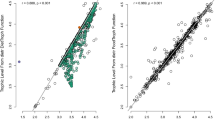Synopsis
Diet overlap measures, commonly used in studies of resource partitioning and competition in fish, are too often treated as fixed values; in fact, they are random variables. Two methods for estimating the variance of some overlap measures using stomach content data are examined here: the jackknife and the bootstrap. Simulation results indicate that the methods work well. In addition, they are valid for either continuous (biomass, percent volume) or discrete (abundance) data. Applications indicate that outliers, such as a stomach much different than others, may have large influence in determing the overlap value.
Similar content being viewed by others
References cited
Bickel, P.J. & D.A. Freedman. 1982. Some asymptotic theory for the bootstrap. Annals of Statistics 9: 1196–1217.
Downing, J.A. 1979. Aggregation, transformation and the design of benthos sampling programs. Fish. Res. Board Can. 36: 1454–1463.
Efron, B. 1978. Bootstrap methods: another look at the jackknife. Annals of Statistics 7: 1–26.
Filliben, J.J. 1975. The probability plot correlation coefficient test for normality. Technometrics 17: 111–117.
George, E.L. & W.F. Hadley. 1979. Food and habitat partitioning between rock bass (Ambloplites rupestris) and smallmouth bass (Micropterus dolomieui) young of the year. Trans. Amer. Fish. Soc. 108: 253–261.
Keast, A.A. 1978. Feeding interrelations between age-groups of pumpkinseed (Lepomis gibbosus) and comparisons with bluegill (L. macrochirus). J. Fish. Res. Board Can. 35: 12–27.
Kravitz, J.J., W.G. Pearcy & M.P. Guin. 1976. Food of five species of coocurring flatfishes on Oregon's continental shelf. U.S. Fish. Bull. 74: 984–990.
Mathur, D. 1977. Food habits and competitive relationships of the bandfin shiner in Halawakee Creek, Alabama. Amer. Midl. Nat. 97: 89–100.
Miller, R.G. 1974. The jackknife: a review. Biometrika 61: 1–15.
Morisita. M. 1959. Measuring of interspecific association and similarity between communities. Memoirs of the Faculty of Science, Kyushu University Series E 3: 64–80.
Petraitis, P.S. 1979. Likelihood measures of niche breadth and overlap. Ecology 60: 703–710.
Schoener. T.W. 1970. Non-synchronous spatial overlap of lizards in patchy habitats. Ecology 51: 408–418.
Smith, E.P. & T.M. Zaret. 1982. Bias in estimating niche overlap. Ecology 63: 1248–1253.
Smith, E.P. 1984. On the likelihood measure of niche overlap. Ecology 65: 323–324.
Smith, W.D., Dravitz, D. & J.F. Grassle. 1979. Confidence intervals for similarity measures using the two sample jack-knife. pp. 253–262. In: L. Orloci, C.R. Rao & W.M. Stiteler (ed.) Multivariate Methods in Ecological Work, International Cooperative Publishing House, Fairland.
Strauss, R.E. 1982. Influence of replicated subsamples and subsample heterogeneity on the linear index of selectivity. Trans. Amer. Fish. Soc. 111: 517–522.
van Belle, G. & I. Ahmad. 1974. Measuring affinity of distributions. pp. 651–658. In: F. Proschan & R.J. Serfling (ed.) Reliability and Biometry: Statistical Analysis of Lifelength, SIAM Publications, Society for Industrial and Applied Mathematics, Philadelphia.
Zahl, S. 1977. Jackknifing an index of diversity. Ecology 58: 907–913.
Zaret, T.M. & E.P. Smith. 1984. On measuring niches and not measuring niches. pp. 127–137. In: T.M. Zaret (ed.) Evolutionary Ecology of Neotropical Freshwater Fishes, Developments in EBF 3, Dr W. Junk Publisher, The Hague.
Zaret, T.M. & S.A. Rand. 1971. Competition in tropical stream fishes: support of the competitive exclusion principle. Ecology 52: 336–342.
Author information
Authors and Affiliations
Rights and permissions
About this article
Cite this article
Smith, E.P. Estimating the reliability of diet overlap measures. Environ Biol Fish 13, 125–138 (1985). https://doi.org/10.1007/BF00002581
Received:
Accepted:
Issue Date:
DOI: https://doi.org/10.1007/BF00002581




